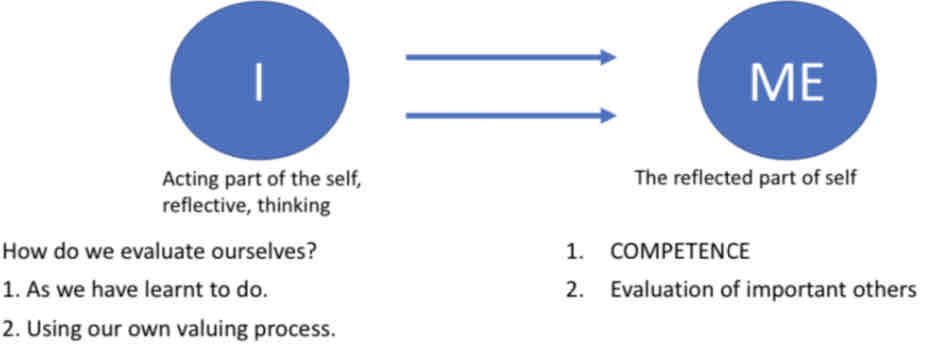PP1 L8: Cognitive theories
1/42
There's no tags or description
Looks like no tags are added yet.
Name | Mastery | Learn | Test | Matching | Spaced |
|---|
No study sessions yet.
43 Terms
Cognitive perspective
A viewpoint in psychology that emphasizes how we organize and integrate information surrounding us.
Behavior in cognitive perspective
Through learning, a behavior set is created (schemas), behavior is constructed: selectively rebuilt from currently available set
Schemas
Mental structures that help individuals organize and interpret information based on prior experiences.
coding strategies (personal construction) by Mischell
Aim: subjective benefit of behavior, can be reframed; Competence: capacity to do smth, affected by previous experiences; Expectancies: mental representations of what we expect from a certain behavior, mediator between behavior and outcome; Self-regulation systems(improve through life): e.g., ideal- ought- and real selves learned/taught, have a temperamental base

Aim of behavior (Mischell)
the subjective benefit of behavior; can be modified through refraiming
Coding strategies (Mischell)
individual differences in personal construction of behavior from schemas
Expectancies (Mischell)
mental representations of what we expect from a certain behavior
Competence (Mischell)
capacity of how someone can do something, affected by personal experiences
Self-regulating systems (Mischell)
( learned or taught by experiences, has temperamental base): self-guides (ideal, ought, and actual selves). Improve throughout life
2 basic assumptions of cognitive perspective
It’s important to understand how people organize and integrate information which surrounds them
With information we make decisions: how you act, what you think is based on those decisions, based on your representation of the world
Coding strategies and personal construction function
how we organize, store, and retrieve personal experiences
Schema
mental representation of information organized based on similar qualities in recurring events
Why are schemas useful?
help make the world more predictable, helps in understanding important aspects and negligating unimportant ones, helps preserve our cognitive capabilities by focusing our attention on important aspects
Content of schemas
implicit and explicit information pieces: abstract knowledge, emotional qualities, information about time sequence, perceptual evidence
Expectations about how things work
Exemplars (example cases) and prototypes (sense of the category as a whole, general meaning
Effects of schemas
direct perception onto important aspects of events, makes easier to remember relevant information, lets make assumptions for information pieces you don’t remember, directs what you’re going to find
Self-esteem
An individual's subjective evaluation of their own worth and self-respect; self-schema
I/Me parts of self-esteem
I: active part of the self, reflective, thinking, learnt self-evaluation using our own valuing process
Me: the reflected part of the self, competence and evaluation of important others

Me as an attitude
Positive self-esteem is a basic need – we need to maintain this positive view, and several cognitive distortions help this process
Cognitive distortions that help maintain positive self-esteem
totalitarian ego (egocentricity, beneffectance, cognitive conservatism) and positive illusions
Totalitarian ego (Greenwald)
three systematic cognitive distortions : egocentricity, beneffectance, cognitive conservatism
Egocentricity
The tendency to view oneself as central to events and experiences; leading role, main character
Beneffectance
The tendency to take credit for positive outcomes while blaming external factors for negative ones.
Cognitive conservativatism
The phenomenon of favoring information that confirms one's pre-existing beliefs.
Positive illusions (Taylor&Brown)
3 illusions that are necessary for mental health and psychological wellbeing: unrealistic positive view of the self (above average effect), illusion of control (exaggerated assessment of personal control over environmental circumstances), and optimism bias (overestimating the likelihood of experiencing positive events)
Possible selves
Concepts referring to the various self-representations individuals envision for their future, both desirable and undesirable.
Self-complexity
The degree to which individuals differentiate and organize various aspects of their self-concept.
Assimilation and accommodation
Processes in cognitive development where individuals integrate new information into existing schemas or adjust their schemas to incorporate new information.
Optimism bias
The tendency to overestimate the likelihood of experiencing positive events.
Multiple selves by William James
3 aspects of the empiric self: material self (material part: body and possessions), social self (knowledge of how others perceive us), spiritual self (consiousness of our cognitive and emotional processes)
Material self, James
our body and possessions
social self James
our knowledge of how others perceive us
spiritual self James
consciousness of our cognitive and emotional processes
4 layers of self by Greenwald & Pratkanis
built around the aim of getting information about our worth: diffuse self, public self, personal self, collective self
Diffuse self (Greenwald)
does not enable differentiation between me-not me. Built around the feeling of joy (similar to the concept of id)
Public self (Greenwald)
sensitive to the evaluation of others, trying to ensure recognition from others
Personal self (Greenwald)
basis of competence, internal personal standards are relevant in directing behaviour
Collective self (Greenwald)
aims to succeed as a member of the reference group, in a specific role. The goal of the self is helping the achievement of group level goals.
Possible selves (Markus&Nurius)
Motivating role of possible self-representations – what we want, and hope vs. What we want to avoid
Undesired self (Ogilvie)
motivating role of avoiding possible self-representations, based on what we observe in others, unfulfilled impulses aiming socially unacceptable acts, or identities already experienced in the past
Self-complexity (Linville)
how many self-concepts a person has and how differentiated they are, can be low and high, affects the intensity of the self-related thoughts and feelings (e.g., self-esteem)
Higgins’ self-discrepancy theory
personality is different domains of the self in interactions: real self and self-guides (ideal and ought/expected selves)
Real self
aspects we possess, viewpoint: me and important others
Ideal self
aspects we would like to possess, ideal based on own values, discrepancy leads to disappointment, depression, and shame